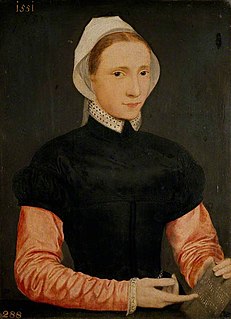Related Research Articles

James Stewart, 1st Earl of Moray, a member of the House of Stewart as the illegitimate son of King James V, was the regent of Scotland for his half-nephew, the infant King James VI, from 1567 until his assassination in 1570. He was the first head of government to be assassinated by a firearm.
William Douglas, 6th Earl of Morton was the son of Robert Douglas of Lochleven and Margaret Erskine, a former mistress of James V of Scotland.

Sir William Kirkcaldy of Grange was a Scottish politician and soldier who fought for the Scottish Reformation but ended his career holding Edinburgh castle on behalf of Mary, Queen of Scots and was hanged at the conclusion of a long siege.
Lady Margaret Erskine was a mistress of King James V of Scotland and mother of Regent Moray.

Agnes Keith, Countess of Moray was a Scottish noblewoman. She was the wife of James Stewart, 1st Earl of Moray, regent of Scotland and the illegitimate half-brother of Mary, Queen of Scots, making her a sister-in-law of the Scottish queen. As the wife of the regent, Agnes was the most powerful woman in Scotland from 1567 until her husband's assassination in 1570.
Alexander Home, 5th Lord Home was a Scottish nobleman and Warden of the Eastern March.

The Siege of St Andrews Castle (1546–1547) followed the killing of Cardinal David Beaton by a group of Protestants at St Andrews Castle. They remained in the castle and were besieged by the Governor of Scotland, Regent Arran. However, over 18 months the Scottish besieging forces made little impact, and the Castle finally surrendered to a French naval force after artillery bombardment. The Protestant garrison, including the preacher John Knox, were taken to France and used as galley slaves.
Thomas McCalzean, Lord Cliftonhall was a 16th-century Scottish judge, rising to be a Senator of the College of Justice and a local politician who was briefly Provost of Edinburgh in 1562 at the personal request of Mary Queen of Scots who sought a moderate influence during these troubled times.
James Stewart, 1st Lord Doune (1529-1590) was a Scottish landowner.
Sir Robert Douglas of Lochleven was a Scottish courtier and landowner.
Jean Lyon, Countess of Angus was a Scottish courtier, landowner, who became involved in a withcraft trial.
John Stewart, Commendator of Coldingham (1531-1563) was a Scottish landowner.
Margaret Douglas, Countess of Bothwell was a Scottish aristocrat and courtier.
Thomas Kerr of Ferniehirst was a Scottish landowner, Roman Catholic and supporter of Mary, Queen of Scots. He and Jean Scott ended the feud between the Scott family and the Kerrs. Thomas and Jean were both involved with supporting Mary, Queen of Scots.

The jewels of Mary, Queen of Scots (1542–1587), are mainly known through the evidence of inventories held by the National Records of Scotland. She was bought jewels during her childhood in France, adding to those she inherited. She gave gifts of jewels to her friends and to reward diplomats. When she abdicated and went to England many of the jewels she left behind in Scotland were sold or pledged for loans, first by her enemies and later by her allies. Mary continued to buy new jewels, some from France, and use them to reward her supporters. In Scotland her remaining jewels were worn by her son James VI and his favourites.

Helen Leslie, Lady Newbattle (1520-1594) was a Scottish aristocrat and supporter of Mary, Queen of Scots.
Michael Gilbert was an Edinburgh goldsmith and financier.
Janet or Jean Scott, Lady Ferniehirst was a Scottish landowner. She was a member of the Border family of Scott who succumbed to an arranged marriage that healed the feud with the family who killed her father. Her marriage to Thomas Kerr of Ferniehirst was successful and she took a role in Scottish politics between the Scottish court and the exiled Mary, Queen of Scots.

James Barroun or Baron was a wealthy Scottish merchant based in Edinburgh and supporter of the Scottish Reformation.

Furniture and furnishings in early modern and late medieval Scotland were made locally or imported, mostly from Flanders and France. Although few pieces of furniture survive from the early part of the period, a rich vocabulary and typology is preserved in inventories and wills. This documentary evidence in the Scots language details the homes of the wealthy and aristocratic.
References
- ↑ Margaret Sanderson, A Kindly Place? Living in Sixteenth-Century Scotland (Tuckwell: East Linton, 2002), pp. 195-6.
- ↑ Margaret Sanderson, A Kindly Place? Living in Sixteenth-Century Scotland (Tuckwell: East Linton, 2002), p. 195.
- ↑ Margaret Sanderson, A Kindly Place? Living in Sixteenth-Century Scotland (Tuckwell: East Linton, 2002), p. 198.
- ↑ Records of the Parliaments of Scotland to 1707, K.M. Brown et al eds (St Andrews, 2007-2020), 1581/10/117. Date accessed: 1 October 2020
- ↑ HMC 6th Report: Moray (London, 1877), p. 657.
- ↑ Margaret Sanderson, A Kindly Place? Living in Sixteenth-Century Scotland (Tuckwell: East Linton, 2002), p. 199.
- ↑ William Fraser, Scots of Buccleuch, vol. 1 (Edinburgh, 1878), p. 568.